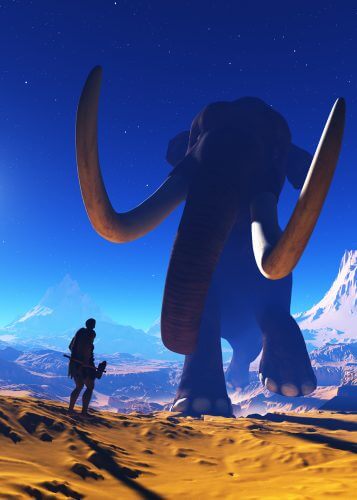Both species came from the warm continent of Africa and lived side by side in Europe for hundreds of thousands of years that included ice ages * This is according to a study published today (7.4.19) in the journal Human Biology

Prof. Ran Barkai and research student Mieded Keslo from the Department of Archeology and Ancient Near Eastern Civilizations at Tel Aviv University conducted the first comparative study of its kind in the world: they compared genes of Neanderthal man and genes of the woolly mammoth - two extinct species, each of which had an African ancestor, which evolved and lived Side by side on the European continent for hundreds of thousands of years, and even shared a common life history. The new research approach brought up fascinating findings: both species have common features in the mechanisms of genetic adaptation to cold climate conditions.
"To this day, quite a few remains of the Neanderthal man and the woolly mammoth have been found across the continent of Europe," explains Prof. Barkai. "It is known that both species had African ancestors, who at some point came north to the European continent - from which the mammoths evolved about 600,000 years ago and the Neanderthal man about 400,000 years ago. There they lived side by side for hundreds of thousands of years, and the Neanderthals even hunted mammoths and extracted from them high-calorie food and raw materials for construction and combustion."
According to Midd Keslo, "Apparently both species also disappeared at about the same time, as a result of processes that reached their peak about 40,000 years ago. From this it can be assumed that the shared history required both species to adapt to the same environmental conditions, and created similar evolutionary pressures. But is this adaptation also reflected in genetic adaptation? To date, the genome of each species has been studied separately, but no comparison has been made between them. This is the task we undertook in this study."
For the purpose of the study, the researchers used databases and existing studies, which contain genetic information extracted from the remains of woolly mammoths and Neanderthals. Indeed, the comparison revealed that the adaptation to the cold climate in general, and during the ice ages in particular, resulted in similar changes in DNA, and that the two species apparently shared similar genes of three types: the LEPR gene responsible for the leptin protein receptors, which is related to the creation of fat tissues and the regulation of body temperature; Genes responsible for the production of keratin - a protein expressed in the structure of hair, skin and nails, which may affect resistance to cold; And the MC1R gene, known as the 'reddish gene', and the SLC7A11 gene responsible for pigmentation, and their effect is visible: at least some of the individuals in both sexes had red hair, which helps better absorption of vitamin D in conditions where sunlight is relatively weak and rare. A comparison with the genome of the ancestors of the woolly mammoths, who lived in Africa, revealed that these genes did not exist in them, and developed in Europe in response to the cold conditions. For the ancestors of the Neanderthal man there is no similar database.
"In our research, we asked a question that had not been asked before about genetic similarity between two apparently distant species," Prof. Barkai concludes. "We created a model of genetic adaptation to environmental conditions, and brought up interesting findings, which give us a broader perspective on our closeness to our animal brothers. We believe that this sacrifice constitutes another layer of man's responsibility towards his partners on earth - specifically towards the elephants, members of the woolly mammoth's family, which are currently in danger of extinction. We also hope that other researchers will adopt our research outline, and ask similar questions regarding other features of the woolly mammoth and the Neanderthal man, and even regarding other animals."

2 תגובות
Interesting and important.
According to many studies, the homo type is to blame for the disappearance of the mammoths
Were these the Neanderthals? Or another species?
Note :
When referring to ice ages, many confuse the concepts,
The concept of an era is supposed to indicate a long time that can be divided into different periods,
Yes: we have been in an ice age for about 35 million years,
Since Antarctica "settled" on the South Pole (about 50 million years ago),
And the continents of Europe and Asia "closed" on the North Pole (about 35 million years ago),
Over time there were warmer periods (due to the Milankovitch cycle)
And cold periods, periods not ages.
I'm sure the researchers are aware of the processes
But perhaps less "sensitive" to differences in language,
Worth fixing...
Are new genes created in humans and animals, or only mutations of existing genes? The article says that new genes have been created to protect against the cold. Is this indeed the intention, or is there simply a linguistic error?